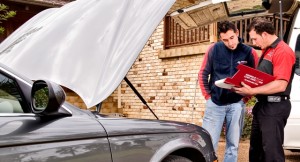 The first three months of the year are the time when many car owners find themselves in the shop trying to get their new vehicle inspection sticker. All too often, it’s a time for nasty surprises and nastier bills. Buyer, beware. Being rushed opens you up to rip-offs. Drivers are in a hurry. They need their cars back, and the outfit doing the inspection is all too happy to do those rush “repairs” or, worse yet, replacements, at a premium price.
The first three months of the year are the time when many car owners find themselves in the shop trying to get their new vehicle inspection sticker. All too often, it’s a time for nasty surprises and nastier bills. Buyer, beware. Being rushed opens you up to rip-offs. Drivers are in a hurry. They need their cars back, and the outfit doing the inspection is all too happy to do those rush “repairs” or, worse yet, replacements, at a premium price.
A word to the wise. Have your trusted mechanic give the car a once over before you go for the new safety sticker. The two most common reasons cars fail to pass inspection are worn brake pads and thin tire tread. Replacing your tires in a rush can be especially pricey. If you do nothing else, have your tires evaluated in advance of your inspection so, if necessary, you have the time to shop for replacements — hopefully on sale.
Acceptable tire tread depth is 2/32 of an inch. Everyone knows you can use a coin to check, but how does that work? If you place a penny in your tire’s tread and part of Lincoln’s head is covered up, you’re above 2/32 of an inch. Opt for a quarter and cover part of Washington’s head, and you’re above a comfortably safe 4/32 of an inch. You can also flip the penny over and use the image of the Lincoln memorial. If the top of the building is covered, your tread is at a generous 6/32 of an inch.
Other equipment that will be checked during your vehicle inspection includes (but may not be limited to):
– horn
– windshield wipers
– mirrors
– steering function
– seat belt and other safety systems
– brakes
– tires and wheel assembly
– exhaust system
– emissions
– lights (front, rear, signal, license plate, turn signals)
– reflectors
– motor, serial, and VIN numbers
– gas caps
You will also be asked to present proof of insurance. (Some aspects of vehicle inspections will vary from state to state, but these are the common inspection elements.)





